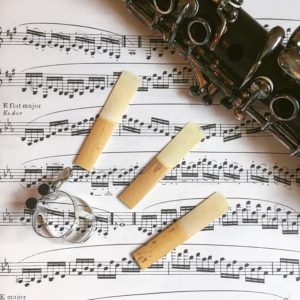The 7 Most Controversial Clarinet Topics
Etiquette dictates that one should never discuss politics, religion, or money in polite company. For clarinetists, there are a few more topics that are sure to spark heated debate.
If you’ve ever visited a clarinet forum or dedicated social media group, you’ve surely seen lively discussions on a variety of topics. Here are a few subjects which seem to frequently pop up. Mention these around clarinetists at your own risk!
(Disclaimer: This is intended as a lighthearted list. I am not choosing sides or trying to start World War Clarinet – research each topic and come to your own opinions!)
- Single lip vs. double lip. The proportion of double lippers to single lippers is quite low, however the double lippers are staunch advocates for spreading the gospel of the double lip embouchure.
- Vibrato. To vibrato, or not to vibrato – that is the question! (I think that’s probably what Shakespeare meant to say in Hamlet.) Clarinetists have been arguing this one out for centuries, so it’s unlikely we’ll reach a consensus any time soon.
- Articulation syllables. It’s amazing how a single syllable can create such a stir in the clarinet community! Whether you’re a loyal practitioner of “tee” or “dee” or “dah” or another syllable, you’re likely to encounter fans for every syllable imaginable.
- Embouchure. Ah, embouchures! Where to begin on such a controversial subject? When you discuss embouchure, you’re opening a giant can of worms. Each mouth and oral cavity is unique, but this doesn’t stop clarinetists from entering heated discussions about flat vs. squishy lower lip, chin position, and a plethora of other embouchure fundamentals. Know all the options and techniques and find what works best for you!
- Equipment. Hardly a day passes by without someone querying “Which mouthpiece/reed/clarinet/ligature is best?” on social media or forums. (Fun fact: Each time somebody asks this questions, thirteen reeds chip somewhere in the world!) Equipment is a lot like Pokémon – you gotta try ’em all and come to your own conclusions.
- Sound concept. This is when it really gets fun! Describing an abstract concept like sound with vague adjectives such as dark, bright, rich, velvety, warm, cool, —insert descriptor of choice— is bound to start an interesting conversation.
- Reeds. One of the best quips I ever heard at a masterclass was when somebody in the audience asked, “What about reeds?” to which the clinician responded, “Yes, reeds are a good idea.” Reeds are a good idea to produce sound – but that’s about all we can agree upon. From brands to cuts to strengths to break-in processes, the subject of reeds is best left to individual discretion.
Remember, clarinet is not one size fits all, so don’t be afraid to research, explore, and utilize whatever works for you! What other controversial clarinet topics would you add to this list?

5 Comments
Wendy W.
Just don’t mention beta blockers, especially if you’re against them, or you’ll start a war.
jennymaclay
Beta blockers are definitely a controversial topic!
Beth Graham
Barrels! (Nuff said)
jennymaclay
Yes! I forgot how controversial barrels could be!
Robert Monie
Just to add a few more:
Do ligatures make a difference? The answers range from no, they do not and absolutely can not (accompanied by various acoustical theories) and a shoe lace, velcro strip, rubber band, or plan old stock ligature is just as good as anything else to yes, they have a significant impact on sound and response and you should get one gold plated (not lacquered), or made of Kevlar string (with gemstones embedded), or suspended on points above the mouthpiece, or solid sterling silver, or made to order by MoMo in Japan.
Asymmetrical facings (that is facings slightly shorter or more open or closed on one side rail than on the other) on mouthpieces provoke the most heated discussions. Though some famous players insist on them, others say they are uncontrollable, impossible to match with a reed, and absolutely wreck the sound.
Cane reeds versus composite (plastic) reeds are another bone of contention. Some reserve composite reeds for special environments like high altitudes and very dry climates. Some were converted from one to the other and switch back and forth. others argue that the cane reed is obsolete (evolution has left cane behind) and still others with just as much heat argue that only cane produces a true and valid clarinet sound (whatever that may be).